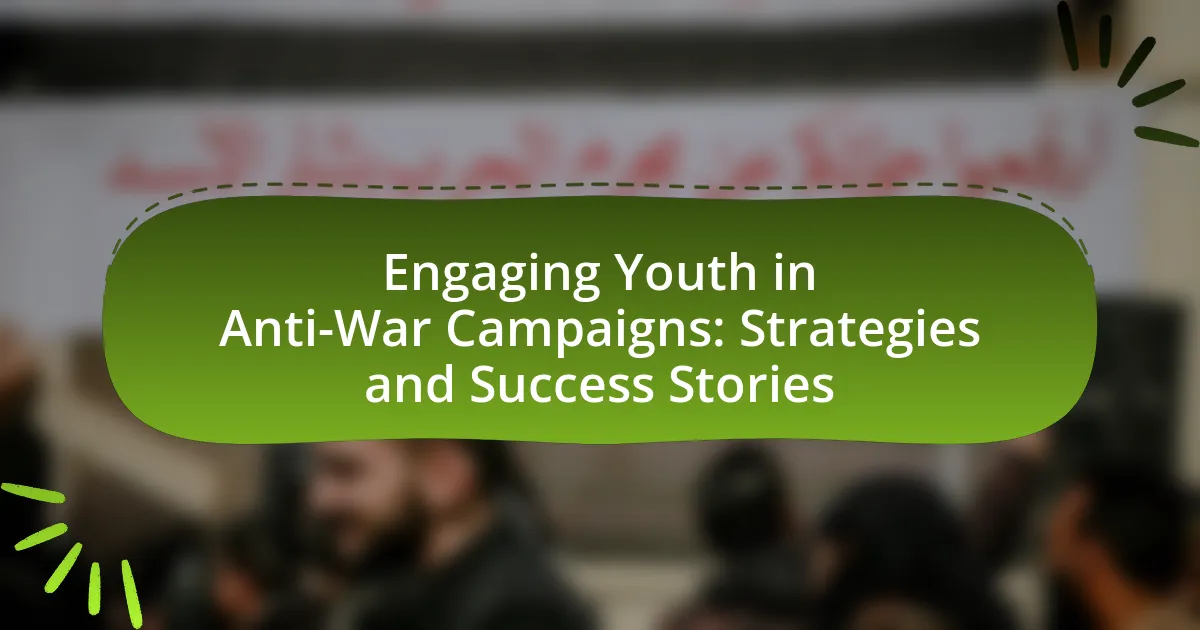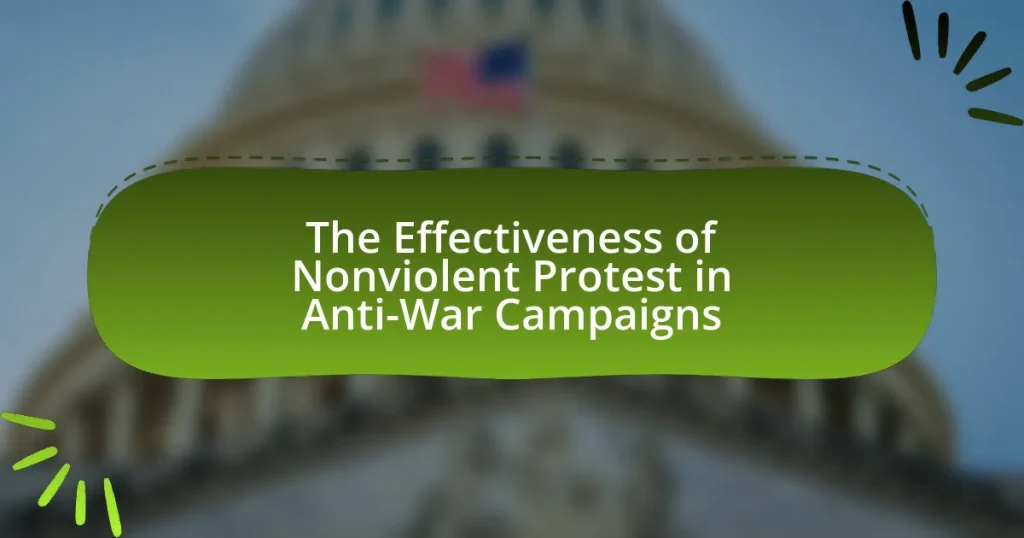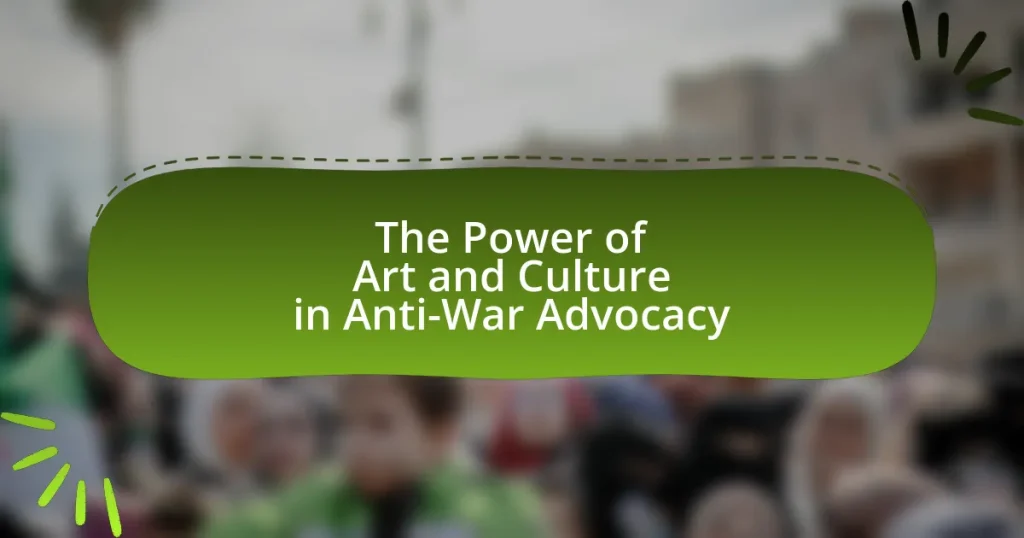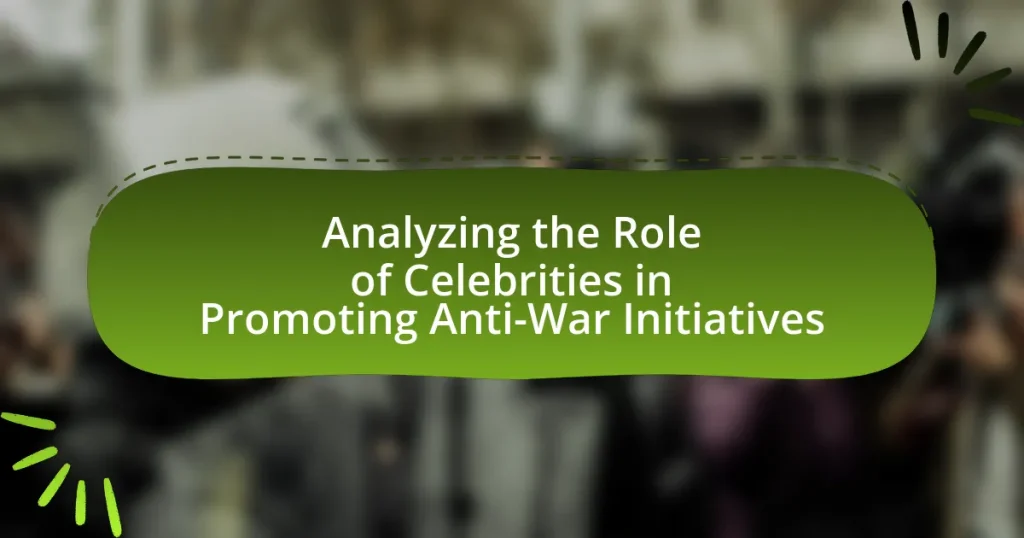The article focuses on engaging youth in anti-war campaigns, highlighting key elements such as education, empowerment, and community involvement. It discusses effective strategies for encouraging youth participation, including the use of social media, peer-led initiatives, and community events. The role of educational institutions in supporting youth activism is examined, along with the unique perspectives young people bring to anti-war discussions. Additionally, the article outlines successful youth-led initiatives and campaigns, emphasizing the importance of grassroots mobilization and effective communication in fostering sustained youth involvement in anti-war efforts.
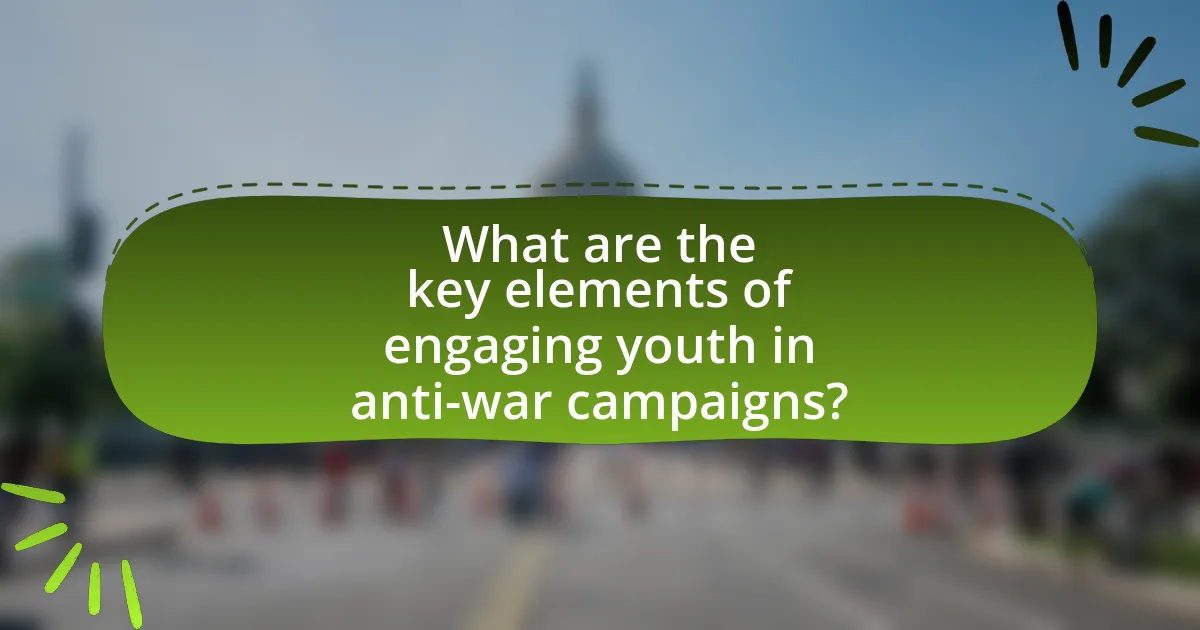
What are the key elements of engaging youth in anti-war campaigns?
The key elements of engaging youth in anti-war campaigns include education, empowerment, and community involvement. Education provides youth with a clear understanding of the consequences of war, fostering critical thinking and awareness of global issues. Empowerment encourages youth to take action, often through leadership opportunities and platforms for their voices to be heard. Community involvement creates a sense of belonging and collective action, allowing youth to collaborate with peers and organizations that share their values. Research shows that youth-led initiatives, such as the March for Our Lives movement, effectively mobilize young people by addressing issues they are passionate about, demonstrating the impact of these elements in real-world scenarios.
How can youth participation be effectively encouraged in anti-war movements?
Youth participation in anti-war movements can be effectively encouraged through targeted education, social media engagement, and community involvement. Educational programs that focus on the historical impacts of war and the benefits of peace can empower young individuals to understand the significance of their involvement. For instance, initiatives like the “Youth for Peace” program have shown that workshops and discussions can increase awareness and motivate action among participants.
Additionally, leveraging social media platforms allows youth to connect, share their views, and mobilize for events, as seen in the success of campaigns like “March for Our Lives,” which utilized social media to organize and amplify youth voices against violence. Community involvement through local organizations can also provide youth with opportunities to participate in activism, fostering a sense of belonging and purpose. Research indicates that when young people feel their contributions are valued, they are more likely to engage actively in movements.
What role do social media platforms play in mobilizing youth for anti-war campaigns?
Social media platforms play a crucial role in mobilizing youth for anti-war campaigns by providing a space for information dissemination, community building, and activism. These platforms enable young people to share their perspectives, organize events, and connect with like-minded individuals, amplifying their voices on a global scale. For instance, during the 2020 anti-war protests in the United States, platforms like Twitter and Instagram were instrumental in spreading awareness and coordinating demonstrations, with hashtags such as #NoWar garnering millions of interactions. This illustrates how social media not only facilitates communication but also fosters a sense of solidarity among youth, empowering them to take collective action against war.
How can educational institutions support youth involvement in anti-war initiatives?
Educational institutions can support youth involvement in anti-war initiatives by integrating peace education into their curricula and providing platforms for student activism. Peace education fosters critical thinking about conflict and promotes values of non-violence, which can be implemented through dedicated courses or workshops. Additionally, schools and universities can facilitate student-led organizations focused on anti-war efforts, offering resources such as funding, meeting spaces, and mentorship from faculty. Research indicates that youth engagement in social movements, including anti-war campaigns, is significantly enhanced when institutions actively promote and support these initiatives, as seen in programs like the Global Campaign for Peace Education, which emphasizes the role of educational settings in fostering a culture of peace.
Why is it important to involve youth in anti-war campaigns?
Involving youth in anti-war campaigns is crucial because they represent the future and possess the energy and creativity needed to drive social change. Engaging young people allows for fresh perspectives on conflict resolution and peacebuilding, which can lead to innovative strategies that resonate with their peers. Historical evidence shows that youth-led movements, such as the 2018 March for Our Lives against gun violence, have effectively mobilized large groups and influenced public policy. Additionally, research indicates that youth participation in civic activities fosters a sense of responsibility and empowerment, making them more likely to advocate for peace and social justice throughout their lives.
What unique perspectives do young people bring to anti-war discussions?
Young people bring fresh, innovative perspectives to anti-war discussions by emphasizing the importance of social media, grassroots activism, and a focus on global interconnectedness. Their adeptness with digital platforms allows them to mobilize quickly, share information widely, and engage diverse audiences, as evidenced by movements like the March for Our Lives and climate strikes, which have utilized social media to amplify their messages. Additionally, young individuals often prioritize issues such as climate change and social justice, recognizing that war exacerbates these challenges, thus framing anti-war arguments within a broader context of sustainability and equity. This generational viewpoint is supported by research from the Pew Research Center, which indicates that younger demographics are more likely to advocate for peaceful resolutions and prioritize diplomacy over military intervention.
How does youth engagement impact the effectiveness of anti-war campaigns?
Youth engagement significantly enhances the effectiveness of anti-war campaigns by mobilizing a passionate demographic that is often more open to activism and social change. Engaged youth bring fresh perspectives, innovative strategies, and a strong presence on social media, which amplifies campaign messages and reaches wider audiences. For instance, the 2018 March for Our Lives movement, led by young activists, effectively utilized social media to advocate for gun control and anti-violence, demonstrating how youth-driven initiatives can garner national attention and influence public discourse. Additionally, research from the Harvard Kennedy School indicates that youth involvement in social movements leads to increased participation rates and greater community mobilization, further validating the critical role of young people in shaping the narrative against war.

What strategies have proven successful in engaging youth in anti-war campaigns?
Successful strategies for engaging youth in anti-war campaigns include leveraging social media platforms, fostering peer-to-peer education, and creating participatory events. Social media campaigns, such as those seen in the “March for Our Lives” movement, effectively mobilize young people by utilizing platforms like Instagram and TikTok to spread awareness and encourage activism. Peer-to-peer education empowers youth to share their perspectives and experiences, enhancing relatability and engagement. Additionally, participatory events, such as workshops and rallies, provide hands-on opportunities for youth to express their views and connect with like-minded individuals, as demonstrated by the success of youth-led protests against military actions in various countries. These strategies have been validated through numerous case studies showing increased youth participation and activism in anti-war movements.
What types of outreach programs are most effective for youth engagement?
Community-based outreach programs, peer-led initiatives, and digital engagement strategies are the most effective for youth engagement. Community-based programs foster a sense of belonging and connection, which is crucial for youth participation; for instance, local workshops and events that address specific issues resonate well with young people. Peer-led initiatives leverage the influence of relatable figures, enhancing trust and participation; studies show that youth are more likely to engage when they see their peers actively involved. Digital engagement strategies, including social media campaigns and online forums, effectively reach tech-savvy youth, allowing for broader participation and interaction. Research indicates that these methods significantly increase youth involvement in social causes, including anti-war campaigns, by creating accessible platforms for expression and action.
How can community events foster youth participation in anti-war efforts?
Community events can foster youth participation in anti-war efforts by providing a platform for education, engagement, and collaboration. These events often include workshops, discussions, and activities that raise awareness about the impacts of war, allowing young people to learn about peacebuilding and conflict resolution. For instance, studies show that youth who participate in community-led initiatives are more likely to develop a sense of agency and responsibility towards social issues, including anti-war movements. Additionally, community events create opportunities for networking and forming alliances with like-minded individuals and organizations, which can amplify their voices and actions against war.
What role do peer networks play in promoting anti-war activism among youth?
Peer networks significantly enhance anti-war activism among youth by fostering a sense of community and shared purpose. These networks provide platforms for discussion, mobilization, and the dissemination of information, which are crucial for raising awareness about the impacts of war. Research indicates that youth are more likely to engage in activism when influenced by their peers, as social connections can amplify individual motivations and collective action. For instance, studies show that youth-led organizations, such as Students for a Democratic Society, have effectively utilized peer networks to organize protests and campaigns, demonstrating the power of collective youth engagement in anti-war efforts.
How can creative expression be utilized to engage youth in anti-war campaigns?
Creative expression can be utilized to engage youth in anti-war campaigns by providing them with platforms to voice their opinions through art, music, and performance. These mediums allow young people to convey their feelings about war and peace in relatable and impactful ways, fostering a sense of community and shared purpose. For instance, initiatives like the “Youth Arts for Peace” program have demonstrated that youth-led art projects can effectively raise awareness and inspire action against war, as seen in the increased participation rates in anti-war demonstrations following such events. Engaging youth through creative expression not only empowers them but also amplifies their messages, making the anti-war movement more resonant and accessible to a broader audience.
What forms of art and media resonate most with young activists?
Young activists are most resonated with digital media, visual art, and music. Digital media, including social media platforms like Instagram and TikTok, allows for rapid dissemination of messages and mobilization of support, evidenced by movements such as Black Lives Matter, which gained traction through viral content. Visual art, such as murals and graphic design, serves as powerful tools for expression and awareness, as seen in the use of street art to convey anti-war sentiments. Music, particularly protest songs, has historically united and inspired youth, with artists like Billie Eilish and Hozier addressing social issues in their lyrics, further engaging young audiences in activism.
How can storytelling be leveraged to inspire youth involvement in anti-war movements?
Storytelling can be leveraged to inspire youth involvement in anti-war movements by creating emotional connections and fostering empathy through relatable narratives. Engaging stories about the impact of war on individuals and communities can resonate with young people, motivating them to take action. For instance, the use of personal testimonies from war survivors or activists can illustrate the human cost of conflict, making the issue more tangible and urgent. Research shows that narratives can significantly influence attitudes and behaviors; a study published in the Journal of Communication found that stories can enhance empathy and increase the likelihood of civic engagement among youth. By utilizing storytelling as a tool, anti-war movements can effectively mobilize young people to participate in advocacy and activism.
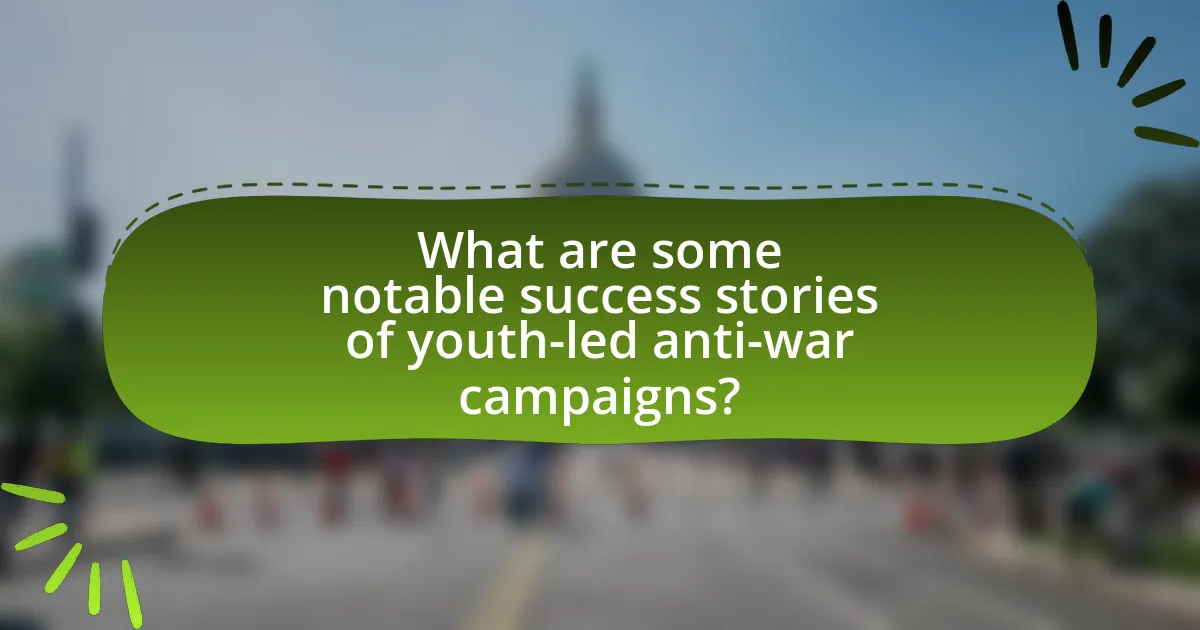
What are some notable success stories of youth-led anti-war campaigns?
Notable success stories of youth-led anti-war campaigns include the Vietnam War protests in the 1960s, where students organized mass demonstrations that significantly influenced public opinion and policy, leading to the eventual withdrawal of U.S. troops. Another example is the “March for Our Lives” movement, initiated by students after the Parkland shooting, which advocated for gun control and highlighted the connection between gun violence and militarization, garnering national attention and legislative discussions. Additionally, the “Fridays for Future” climate strikes, led by youth activists like Greta Thunberg, have linked climate action to peace, emphasizing the need for global cooperation over militarization, thus reshaping discourse around war and environmental issues. These campaigns demonstrate the power of youth mobilization in effecting change and influencing policy.
Which youth-led initiatives have made a significant impact in anti-war efforts?
Youth-led initiatives such as the “Youth for Peace” movement and “Students for a Democratic Society” have made significant impacts in anti-war efforts. “Youth for Peace” mobilizes young people globally to advocate for non-violent conflict resolution and has organized numerous campaigns against military interventions, notably during the Iraq War. Similarly, “Students for a Democratic Society,” active since the 1960s, has historically focused on opposing U.S. military actions and promoting social justice, influencing public opinion and policy through protests and educational outreach. These initiatives demonstrate the power of youth activism in shaping anti-war discourse and mobilizing communities against militarization.
What strategies did these successful campaigns employ to engage young people?
Successful campaigns engaged young people through the use of social media, relatable messaging, and grassroots organizing. Social media platforms like Instagram and TikTok were utilized to reach younger audiences effectively, allowing campaigns to share visually appealing content that resonated with youth culture. Relatable messaging focused on issues that directly impacted young people, such as education, employment, and social justice, making the campaigns more relevant and compelling. Grassroots organizing involved mobilizing local communities and encouraging peer-to-peer engagement, which fostered a sense of ownership and empowerment among young participants. These strategies have been shown to increase participation rates and enhance the overall impact of anti-war campaigns targeting youth.
How did these campaigns measure their success and impact?
These campaigns measured their success and impact primarily through quantitative metrics such as participation rates, social media engagement, and fundraising totals. For instance, campaigns often tracked the number of youth participants involved in events, which provided a clear indicator of outreach effectiveness. Additionally, social media analytics, including likes, shares, and comments, were utilized to gauge public sentiment and engagement levels. Fundraising totals served as another critical metric, reflecting the financial support and community backing for the initiatives. These metrics collectively offered a comprehensive view of the campaigns’ reach and resonance among the youth demographic.
What lessons can be learned from successful youth engagement in anti-war campaigns?
Successful youth engagement in anti-war campaigns demonstrates the importance of grassroots mobilization, effective communication, and leveraging social media. Grassroots mobilization allows young people to organize locally, creating a sense of community and shared purpose, as seen in the 2003 Iraq War protests where youth-led organizations played a pivotal role in mobilizing thousands. Effective communication, particularly through relatable messaging, resonates with peers and can influence public opinion, as evidenced by the “Not In Our Name” campaign, which effectively articulated the moral implications of war. Additionally, leveraging social media platforms enables rapid dissemination of information and fosters global connections, exemplified by the #NeverAgain movement, which utilized social media to advocate against gun violence and militarization. These lessons highlight the need for youth to harness their collective power, articulate clear messages, and utilize modern communication tools to drive impactful anti-war initiatives.
How can these lessons be applied to future anti-war initiatives?
Lessons from past anti-war initiatives can be applied to future campaigns by emphasizing grassroots mobilization and leveraging digital platforms for outreach. Historical examples, such as the Vietnam War protests, demonstrate that youth engagement through social media can amplify messages and foster community involvement. Additionally, incorporating educational programs that focus on the consequences of war can empower young activists to advocate effectively. Research indicates that youth-led movements, like the March for Our Lives, have successfully influenced policy discussions, highlighting the importance of sustained activism and collaboration with established organizations to create a unified front against war.
What best practices should be adopted for sustained youth involvement in anti-war efforts?
Sustained youth involvement in anti-war efforts can be achieved through education, empowerment, and community engagement. Educational initiatives that focus on the historical context of wars and their impacts can foster critical thinking and awareness among youth. Empowerment through leadership opportunities in organizations allows young individuals to take active roles in advocacy, enhancing their commitment to anti-war causes. Community engagement, such as organizing local events or participating in global movements, creates a sense of belonging and shared purpose, which is crucial for long-term involvement. Research indicates that youth who feel connected to their communities and informed about global issues are more likely to remain engaged in activism, as seen in various successful youth-led movements worldwide.
What practical tips can enhance youth engagement in anti-war campaigns?
To enhance youth engagement in anti-war campaigns, organizations should utilize social media platforms effectively to reach and mobilize young audiences. Research indicates that 90% of young people use social media, making it a powerful tool for spreading awareness and fostering community involvement. Campaigns can create engaging content, such as videos and infographics, that resonate with youth values and encourage participation. Additionally, providing opportunities for youth leadership within campaigns can empower them, as studies show that youth-led initiatives often yield higher engagement rates. Collaborating with schools and universities to integrate anti-war education into curricula can also increase awareness and motivate action among students.
